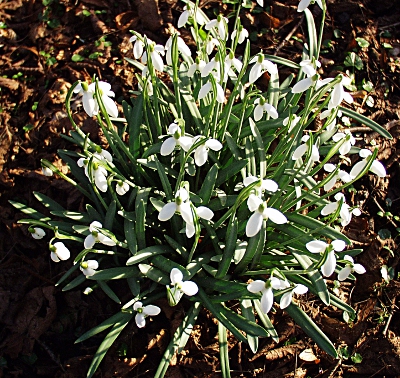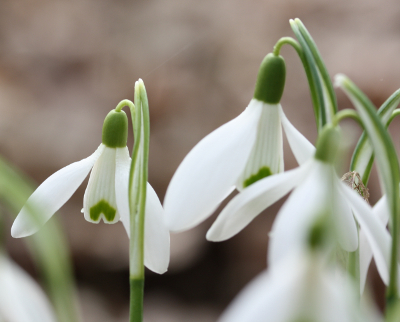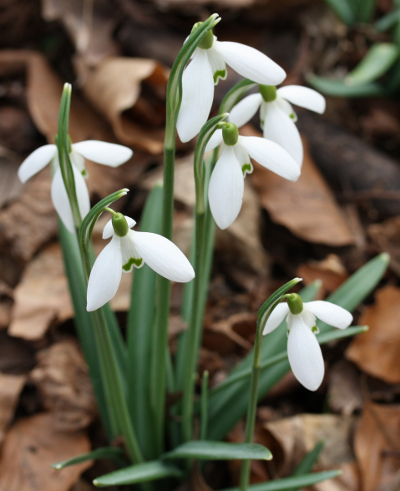Snowdrops |

The formation of bulblets causes growing in clumps

Flowers of the common snowdrop

Snowdrops can produce heat in their bulbs
Comprising some 20 species, the genus has its origins in Central Europe and adjacent parts of Asi.,It exclusively consists of herbaceous bulbous plants.
In early spring the plant pushing out and initially forms usually two basal, parallel-veined leaves from a bulb. From the middle of the bulb then grows the scape. First, the bud is wrapped by a bract. This is then broken up before anthesis and remains on the scape as a single leaf. Produced from seed the snowdrop needs up to 3 years to form flowers.
The fragrant flower consists of 2 circles, each with 3 tepals. The 3 outer ones are white and spreading, the inner ones are much shorter. They overlap and form a white tube that shows green marks. The ovary is grown from 3 carpels. The 6 stamens stand in two circles and possess pointed anthers which stand close together.
| Floral formula: |
| * P3+3 A3+3 G(3) inferior |
After pollination by insects the ovary forms a capsule containing about 25 seeds. The seeds have an appendage that is attractive to ants, called elaiosome. The ants eat it and so they spread the seeds in the direct vicinity. The plants also multiply by the formation of bulblets. The latter are formed in the axils of the fleshy scales of the bulb and separate later from the progenitor. Next year, the old and the new bulbs sprouting, so that the plants grow in clumps.
Herbal heat production
The bulbs of snowdrops can generate temperatures of 8–10 °C. So the snow melts and the way is clear. This also ensured sunlight and water supply.
But how
produce the bulbs heat? To understand this, one has to involve a little
bit knowledge of cell biology:
The
bulb stores starch as reserve material. Starch consists of many
interlinked glucose molecules, a kind of sugar. Enzymes break down the
starch in many glucose units. They are metabolized in the so-called
Glycolysis, a metabolic pathway. There, the glucose is split into two
molecules of pyruvate. This energy is released. It is stored in a
molecule called ATP.
In the citric acid cycle, a further metabolic pathway, the pyruvate is converted into carbon dioxide. This gives compounds which easily releases hydrogen. These are used in the cellular respiration. They transfer hydrogen to oxygen molecules, so that water is formed.
The released energy is usually re-invested in the production of ATP. In the case of the bulb, energy released is not always stored in ATP. It is said that the cell breathing is uncoupled from ATP synthesis. Thus the energy that is released in the formation of water is converted into heat.
Galantamine as a drug against Alzheimer's disease
Snowdrop contain toxic alkaloids, including the galantamine. It is industrially produced as a drug to treat Alzheimer's disease. One symptom of Alzheimer's disease is a disorder of certain neurotransmitters in the brain.
Here, the so-called acetylcholine is cleaved by an enzyme, so that the transmission of impulses in the nervous system is interrupted. Galantamine may temporarily block this enzyme, which has a positive effect on the symptoms.
Meaning of the species name
- nivalis: lat. nivalis = snow-
Interessantes am Rande
-
Snowdrops herald the coming of spring. Not only people delight in the early bloomers, but they are also one of the first nectar sources for insects.
-
The snowdrops that grow wild in Emsland are feral garden escapes, originally they did not occur in this area. Presumably they were introduced as ornamental plants mid-16th century.
-
There are over 500 different cultivated varieties of snowdrop, which often differ only slightly. However, there are also forms with double flowers, with very big flowers or plants, whose inner petals are completely green.
-
Galanthus regina-olgae is an autumn-flowering snowdrop.